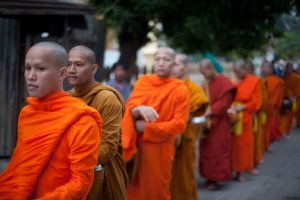Last week, Radio Free Asia reported that UNESCO has requested an assessment for a planned hydropower dam close to the town of Luang Prabang, fearing that the dam’s potential impact could put the World Heritage Site at risk.
Luang Prabang is the former center of the precolonial Lan Xang kingdom and has remained an important spiritual and religious center in the centuries since. UNESCO added Luang Prabang to its World Heritage list in 1995, describing its antique old town as “an outstanding example of the fusion of traditional architecture and Lao urban structures with those built by the European colonial authorities in the 19th and 20th centuries.”
Just 25 kilometers upstream of the town, however, Laos’s communist government is planning to construct a gargantuan 1,460-megawatt dam. The $3 billion project, a joint venture involving Petro Vietnam Power Corporation and Thailand’s CH Karnchang, is scheduled to begin construction this year and finish in 2027.
While the dam will be built outside the boundaries of the World Heritage Site, Dr. Mechtild Rossler, director of the UNESCO World Heritage Center in Paris told Radio Free Asia’s Lao service that it is “quite close to the site, and as the Mekong River Commission expressed concerns about the security and safety standards, we have been looking into that question.”
It’s a reasonable concern. In July 2018, a wall collapsed on a dam that was under construction in southern province of Attapeu, producing a surge of water that killed around 40 people and displaced many thousands.
The Luang Prabang dam is just one of a cascade of Mekong dams that the Lao government has slated as part of its plan of turning the land-locked country into the “battery of Southeast Asia.”
As Tom Fawthrop wrote in these pages in December, Laos has also built a dam, the Xayaburi hydropower project, downstream of Luang Prabang. If this new upstream project goes ahead, he argued, it would impede the flow of the Mekong and Nam Khan rivers, which flank the temple-studded town, which celebrated its 25th anniversary as a World Heritage Site last year.
As Minja Yang, the former deputy director of UNESCO’s World Heritage Center told Fawthrop, “UNESCO signed the 1995 Agreement with the Lao government based on the unique links between nature, culture, and history along the confluence of the Mekong and Khan rivers. If the site becomes a ‘lakeside’ town and no longer a riverside town, the authenticity as well as its integrity will be lost forever.”
UNESCO’s call for a special heritage assessment is just the latest sign of the growing disquiet about the environmental, social, and economic impacts of Laos’ dam-building plans, including from fellow members of the Mekong River Commission. It also hints at the increasing pressures that development has put on Luang Prabang’s fragile cultural assets.
Since its listing by UNESCO in 1995, the town has gone from an impoverished settlement with a stuttering electricity supply to one of Southeast Asia’s prized boutique travel destinations. Rocketing tourist numbers have put a heavy strain on the town’s tourist infrastructure.
As early as 2004, UNESCO noted in a report that tourism development had already put a “critical stress” on the town’s environmental and cultural resources. Without proper management, it warned, Luang Prabang could well become “another tourist town where soft-drink billboards dominate the landscape, where the sound of tour buses drowns out the soft temple prayers and where the town’s residents are reduced to the roles of bit-players in a cultural theme park.”
While COVID-19 has brought much of this growth to a temporary halt, the longer-term trends are clear. Luang Prabang will be a station on the Chinese-built railway running from Yunnan province to the Lao capital Vientiane, which is set to open later this year, and is also increasingly linked to China and its Southeast Asian neighbors by road and air links.
All this makes it clear that the Lao government needs a long-term plan to safeguard Luang Prabang’s World Heritage Status, a valuable economic asset for the country. Its breakneck hydropower developments unfortunately point in the opposite direction.

































